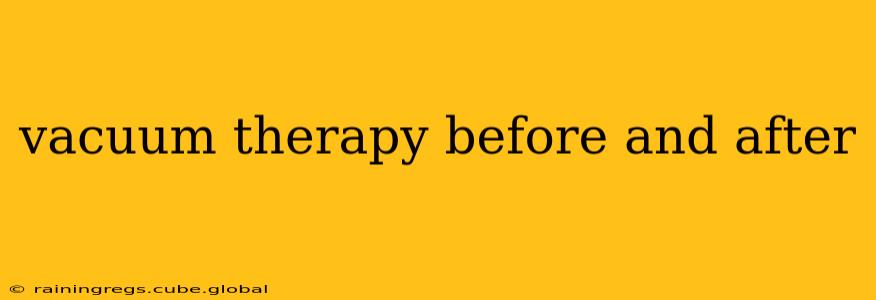Vacuum therapy, also known as negative pressure therapy, is a non-invasive treatment gaining popularity for various aesthetic and therapeutic applications. This comprehensive guide explores the before-and-after experiences associated with vacuum therapy, addressing common questions and concerns. We'll delve into its uses, potential benefits, and what you should expect throughout the process.
What is Vacuum Therapy Used For?
Vacuum therapy utilizes suction to stimulate blood flow and lymphatic drainage in targeted areas. Its applications are diverse, including:
- Cellulite Reduction: By improving circulation and breaking down fat deposits, vacuum therapy can help reduce the appearance of cellulite.
- Body Contouring: It can help to sculpt and shape the body by targeting areas with excess fat or loose skin.
- Scar Tissue Treatment: The increased blood flow can help to soften and reduce the appearance of scars.
- Lymphatic Drainage: It promotes the removal of toxins and excess fluid, potentially relieving swelling and improving skin tone.
- Muscle Relaxation and Pain Relief: Vacuum therapy can be used to alleviate muscle tension and pain in certain conditions.
What to Expect Before Your Vacuum Therapy Session
Before your first session, it's crucial to consult with a qualified practitioner. They will:
- Assess your health history: Discuss any medical conditions, allergies, or medications you're taking.
- Evaluate your treatment goals: Determine the areas to be treated and realistic expectations.
- Explain the procedure: They'll detail the process, potential side effects, and aftercare instructions.
- Perform a skin assessment: To ensure suitability for the treatment and identify any contraindications.
What Happens During a Vacuum Therapy Session?
A typical session involves applying a specialized cup or device to the targeted area. The suction created draws the skin upwards, stimulating blood flow and lymphatic drainage. The intensity of the suction and duration of the treatment will vary depending on your individual needs and the practitioner's assessment.
Vacuum Therapy: Before and After Photos – What Can I Expect to See?
While individual results vary, many experience noticeable improvements after a series of sessions. Before-and-after photos often show:
- Reduced cellulite dimpling: The skin appears smoother and more even.
- Improved skin tone and texture: The skin may look tighter and more firm.
- Decreased circumference in targeted areas: A reduction in inches is possible, particularly in areas with excess fat.
- Softening of scar tissue: Scars may become less noticeable and less raised.
It's important to note that results are not instantaneous. A course of several sessions is usually necessary to achieve significant improvements. Your practitioner will provide a personalized treatment plan based on your individual needs and goals.
How Long Does it Take to See Results from Vacuum Therapy?
The timeframe for seeing noticeable results varies depending on several factors, including the individual's body type, the area treated, and the number of sessions undertaken. Some individuals may see improvements after just a few sessions, while others may require a more extensive course of treatment. It's essential to maintain realistic expectations and follow your practitioner's recommendations for optimal results.
What are the Potential Side Effects of Vacuum Therapy?
Vacuum therapy is generally considered a safe procedure, but potential side effects can include:
- Temporary bruising or redness: This is usually mild and resolves within a few days.
- Mild discomfort or soreness: This is temporary and usually subsides quickly.
- Skin sensitivity: The treated area might be slightly more sensitive to touch for a short period.
Serious side effects are rare, but it's crucial to choose a qualified and experienced practitioner to minimize risks.
Is Vacuum Therapy Right for Me?
Vacuum therapy may be a suitable option if you're looking for a non-invasive way to improve the appearance of cellulite, contour your body, or address certain skin concerns. However, it's crucial to consult with a qualified healthcare professional or aesthetician to determine if it's the right treatment for you and to discuss any potential risks or contraindications. They will assess your individual needs and help you make an informed decision.
Maintaining Results After Vacuum Therapy
While vacuum therapy can produce noticeable improvements, maintaining those results often requires a healthy lifestyle. This includes regular exercise, a balanced diet, and adequate hydration. Your practitioner may also recommend additional treatments or home care products to support long-term results.
Remember, the information provided here is for general knowledge and shouldn't substitute professional medical advice. Always consult with a qualified practitioner before undergoing any cosmetic or therapeutic procedure.
